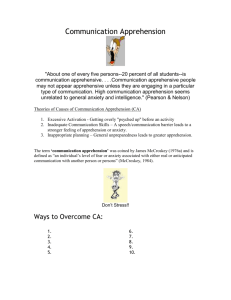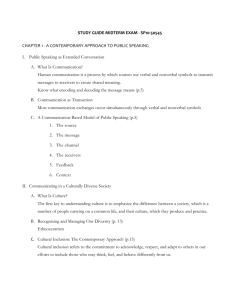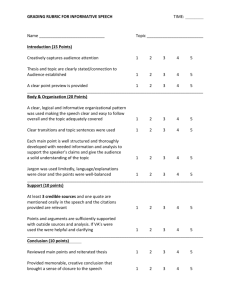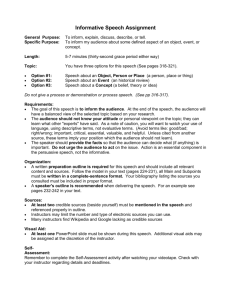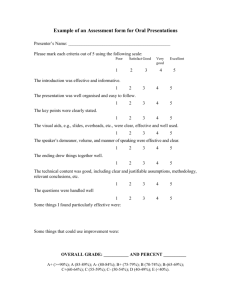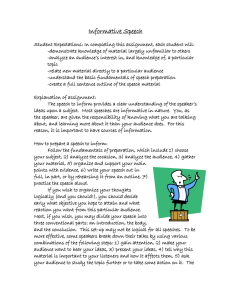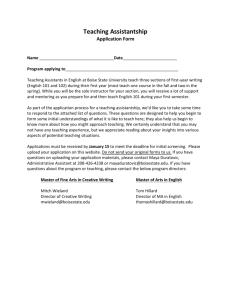study guide midterm exam -‐ sp10-‐31153 chapter 1
advertisement
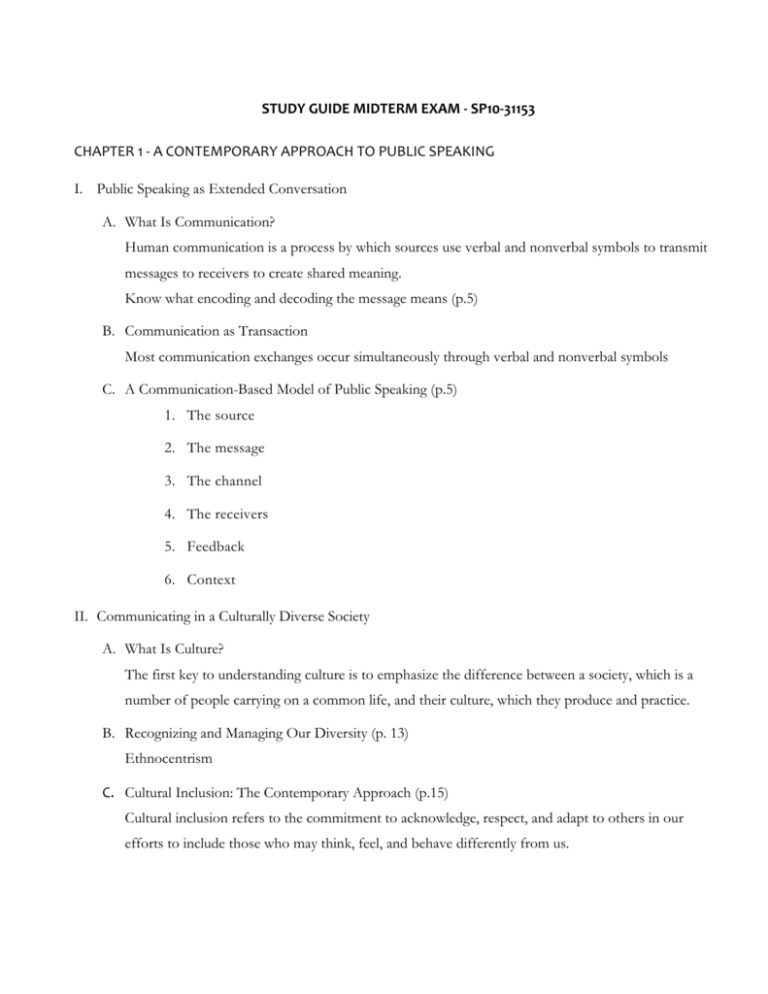
STUDY GUIDE MIDTERM EXAM -­‐ SP10-­‐31153 CHAPTER 1 -­‐ A CONTEMPORARY APPROACH TO PUBLIC SPEAKING I. Public Speaking as Extended Conversation A. What Is Communication? Human communication is a process by which sources use verbal and nonverbal symbols to transmit messages to receivers to create shared meaning. Know what encoding and decoding the message means (p.5) B. Communication as Transaction Most communication exchanges occur simultaneously through verbal and nonverbal symbols C. A Communication-Based Model of Public Speaking (p.5) 1. The source 2. The message 3. The channel 4. The receivers 5. Feedback 6. Context II. Communicating in a Culturally Diverse Society A. What Is Culture? The first key to understanding culture is to emphasize the difference between a society, which is a number of people carrying on a common life, and their culture, which they produce and practice. B. Recognizing and Managing Our Diversity (p. 13) Ethnocentrism C. Cultural Inclusion: The Contemporary Approach (p.15) Cultural inclusion refers to the commitment to acknowledge, respect, and adapt to others in our efforts to include those who may think, feel, and behave differently from us. CHAPTER 3-­‐THE INFLUENCE OF CULTURE ON PUBLIC SPEAKING I. The Influence of Culture on Communication (p.34) In this book, intercultural communication is defined as message exchange between co-cultural backgrounds distinct enough to change the event. A. Cultural Features That Make a Difference 1. High and low context (p.36) 2. High and low power distance (p.37) Power is distributed differently among different cultures. Some cultures minimize power and status differences; others place a high value on social, birth order, or occupational status and political rankings. II. Co-Culturally Unique Styles of Speaking Ethnocentrism (p.40) CHAPTER 4-­‐ DEVELOPING CONFIDENCE: COPING WITH YOUR FEARS ABOUT PUBLIC SPEAKING I. Communication Apprehension as a Common Reaction A. Apprehensive Situations (p.57) Highly apprehensive individuals fear communication in most any situation; this is called traitlike apprehension. Individuals low in trait apprehension seek out communication situations. Most individuals are moderately apprehensive. B. Apprehensive Cultural Groups (pp.58-9) The norms for communication apprehension vary worldwide. Some cultures, such as Japan and Micronesia, are naturally apprehensive about communication; others, such as Puerto Ricans or Filipinos, are much less apprehensive. II. Causes of Public Speaking Anxiety ("Stage Fright") (pp. 59-62) A. Feeling Conspicuous and Inspected Being singled out, with the attention of an audience directly on the speaker, causes communication anxiety. B. Undergoing Evaluation The sense of being appraised as a speaker heightens communication anxiety. C. Relying on English as a Second Language Communication apprehension may be especially high when a speaker speaks before an audience whose primary language is different from his or her own. III. Dealing with Communication Apprehension A. Reducing Your Fears 1. Cognitive restructuring (pp. 64-65) 2. Skills training (p.66) CHAPTER 11-­‐ Speaking To Inform I. Goals and Types of Informative Speeches A. Goals of Informative Speaking (p.192)) Be able to distinguish between informative and persuasive speaking. Specify your intend in the specific purpose statement 1. Updating Old Information (p.193) B. Types of Informative Speeches 1. Lectures provide new or additional information about a particular subject; audience members are usually referred to as students. 2. Demonstrations are a short how-to speech explaining a particular activity or use a specific object. 3. Training presentations teach listeners to understand a concept or to complete a task with an acceptable degree of accuracy. Training usually involves adult learners who are required to attend and learn from the demonstration. II. Organizing and Outlining an Informative Speech (p.195) A. The introduction should compel the audience to listen with an attention-getter. B. The body of the informative speech should contain no more than three main points, organized in a way that helps the audience make sense of the message. (p. 196) III. Strategies for Increasing Informational Effectiveness A. Keep It Simple (p. 200) The fewer points the speech presents, the more likely the audience will learn them. Too many numbers or statistics bore the audience. B. Be Repetitive and Redundant Repetition refers to explaining something exactly the same way over and over again. Redundancy involves explaining something more than once, but in a slightly different way each time. Without repetition and redundancy, the audience may fail to understand or simply miss key issues and explanations. Both strategies are especially important when speaking to audiences who communicate in English as their second or third language. C. Use Transitions and Signposts Signposts are simple words or phrases that signal organization. CHAPTER 6-­‐ ANALYZING AND ADAPTING TO DIVERSE AUDIENCES I. Analyzing Your Audience Audience analysis is the systematic gathering of information about an audience in an effort to learn everything possible about it that is relevant to the topic. A. Audience Demographics (p. 95) Demographic makeup refers to the social characteristics of the audience. Analysis by social categories (e.g., gender, age, and religion) can reveal beliefs and orientations that audience members are likely to share and that are likely to affect how they will respond to a particular topic, an approach to that topic, and a particular speaking style. B. Audience Psychographics Audience psychographics seek to determine what kinds of attitudes, beliefs, and opinions people share. A psychographic audience analysis includes the audience's motives for being in the audience; its interests in and knowledge of the speaker's topic; and the audience members' personal feelings. C. Adapting to Your Audience (p. 103) Audience adaptation refers to the process of adjusting one's topic, purpose, language, and communication style in order to avoid offending or alienating members of the audience and to increase the likelihood of achieving the goals of making the speech. 1. Dealing with Co-Culturally Dissimilar Audiences by: Target the purpose of the speech to the specific co-culture that you address. CHAPTER 8-­‐ SELECTING AND RESEARCHING YOUR TOPIC I. Selecting a Topic A. Selecting a General Area or Subject (p.131) Brainstorming B. Specifying Your Purpose (pp. 135-136) Specify the purpose of the presentation by telling the audience that it is meant to inform, entertain, or persuade. C. Formulating a Thesis Statement II. Researching Your Topic A. Types of Support 1. Eyewitness accounts, stories, and quotable phrases These types of support make the presentation more personal, sincere, and humanistic. Audiences are more likely to agree with a speaker who demonstrates a personal connection with the speech topic. B. Evaluating Sources from the Internet 1. Relevancy (p.147) The degree of association between the reference and the topic 2. Recency 3. Credibility Evidence consistent with other known facts or data
